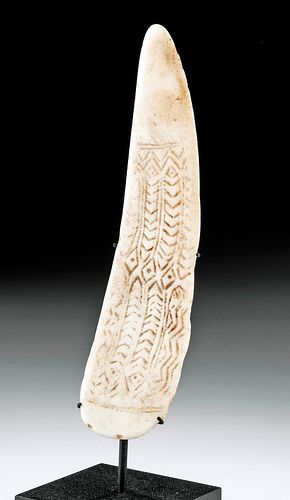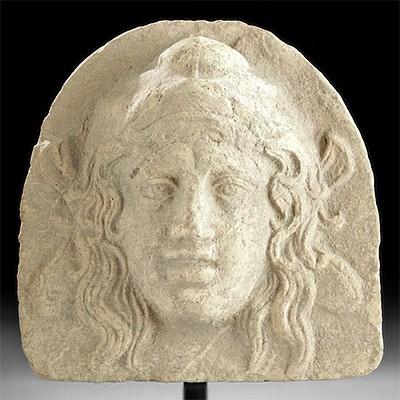Ancient Tonga Lapita Incised Shell Artifact w/ Catalog
Lot 164a
About Seller
Artemis Fine Arts
686 S Taylor Ave, Ste 106
Louisville, CO 80027
United States
Selling antiquities, ancient and ethnographic art online since 1993, Artemis Gallery specializes in Classical Antiquities (Egyptian, Greek, Roman, Near Eastern), Asian, Pre-Columbian, African / Tribal / Oceanographic art. Our extensive inventory includes pottery, stone, metal, wood, glass and textil...Read more
Categories
Estimate:
$2,200 - $2,800
Absentee vs Live bid
Two ways to bid:
- Leave a max absentee bid and the platform will bid on your behalf up to your maximum bid during the live auction.
- Bid live during the auction and your bids will be submitted real-time to the auctioneer.
Bid Increments
| Price | Bid Increment |
|---|---|
| $0 | $25 |
| $300 | $50 |
| $1,000 | $100 |
| $2,000 | $250 |
| $5,000 | $500 |
| $10,000 | $1,000 |
| $20,000 | $2,500 |
| $50,000 | $5,000 |
| $100,000 | $10,000 |
| $200,000 | $20,000 |
About Auction
By Artemis Fine Arts
Feb 27, 2020
Set Reminder
2020-02-27 10:00:00
2020-02-27 10:00:00
America/New_York
Bidsquare
Bidsquare : VARIETY SALE | Antiquities & Ethnographic Art
https://www.bidsquare.com/auctions/artemis-gallery/variety-sale-antiquities-ethnographic-art-4920
Around the world & back in time - be amazed at the treasures you will find. Antiquities from Egypt, Greece, Italy and the Near East, Asian, Pre-Columbian, African / Tribal / Oceanic, Native American, Spanish Colonial, Russian Icons, Fine Art, much more! Artemis Fine Arts info@artemisfinearts.com
Around the world & back in time - be amazed at the treasures you will find. Antiquities from Egypt, Greece, Italy and the Near East, Asian, Pre-Columbian, African / Tribal / Oceanic, Native American, Spanish Colonial, Russian Icons, Fine Art, much more! Artemis Fine Arts info@artemisfinearts.com
- Lot Description
West Polynesia, Tonga Island, Lapita Culture, ca. 1000 to 600 BCE. An oblong shaped white shell object - most likely Giant Clam (Tridacna gigas) - that is finely carved with abstract imagery - perhaps representing fish or other marine creatures on the front face - and was likely used during ritual rites. The verso presents beautiful natural shell patterns. According to "Lapita Oceanic Ancestors, "Rather than shell being a simple equivalent for stone in an area generally poor in good lithic resources, it is apparent that artefacts in shell have a distinct importance to Lapita peoples in their own right." Size: 6.5" H (16.5 cm); 7.5" H (19 cm) on included custom stand.
The Lapita peoples originated in Taiwan and other regions of East Asia. As seafaring explorers and colonists, they settled on the Bismarck Archipelago (northeast of New Guinea) by 2000 BCE, and by 1600 BCE they also ventured to the Solomon Islands, reaching Fiji, Tonga, and other parts of western Polynesia by 1000 BCE. By 500 BCE they migrated to Micronesia.
For a comprehensive source about Lapita visual culture, see the catalogue "Lapita Oceanic Ancestors" (2010) by the Musee du Quai Branly, included with this piece. "Lapita Oceanic Ancestors" was a landmark exhibition that took place in France to focus on this ancient Oceanic civilization. According to Veronique Mortaigne's review of this exhibition, "The term "Lapita" was coined in 1952: an American, Edwin Gifford, was digging on the Foue peninsula. He asked a Kanak for the name of the site, but mistook the response, xapeta'a, for 'Lapita'. In the Haveka language spoken by the Kanaks xapeta'a means 'the place where one digs'. It was assumed initially that this referred to the work of the archaeologists. But it finally emerged that the Kanaks had understood that the land had been settled before their arrival."
Provenance: private Hawaii, USA collection; ex-private Hurst collection, Cambridge, Massachusetts, USA
All items legal to buy/sell under U.S. Statute covering cultural patrimony Code 2600, CHAPTER 14, and are guaranteed to be as described or your money back.
A Certificate of Authenticity will accompany all winning bids.
We ship worldwide and handle all shipping in-house for your convenience.
#148352Minute nicks to the peripheries that have smoothed over the ages. Normal surface wear commensurate with age, but the imagery is still strong.Condition
- Shipping Info
-
All shipping is handled in-house for your convenience. Your invoice from Artemis Gallery will include shipping calculation instructions. If in doubt, please inquire BEFORE bidding for estimated shipping costs for individual items.
-
- Buyer's Premium



 EUR
EUR CAD
CAD AUD
AUD GBP
GBP MXN
MXN HKD
HKD CNY
CNY MYR
MYR SEK
SEK SGD
SGD CHF
CHF THB
THB















